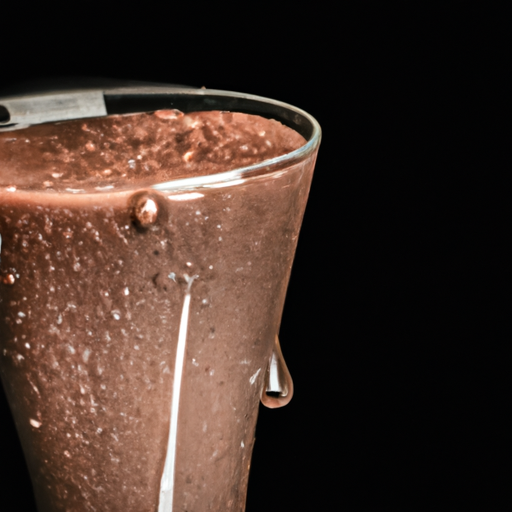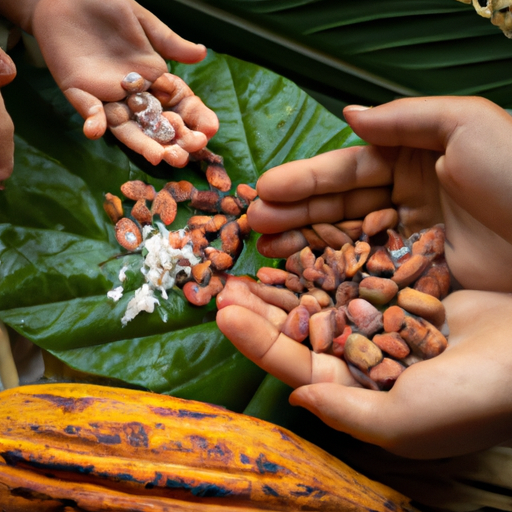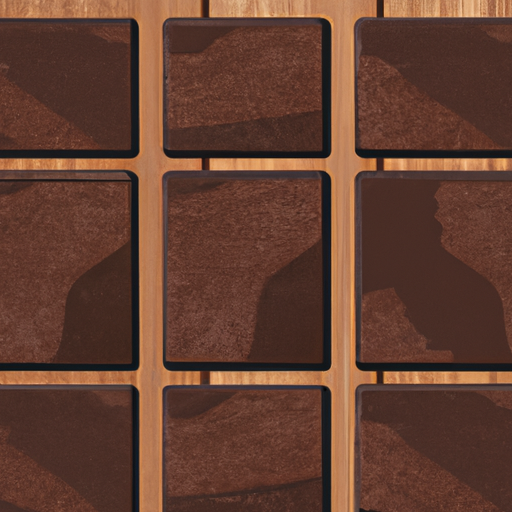Looking for a tasty and healthy drink? Let me tell you about **raw cacao and water** – a surprising mix that’s just perfect! This **smooth** cacao with the simple **refreshment** of water makes a special and energizing beverage that not only fills you up but also benefits your health. Curious to find out more?
In this article, I will delve into the numerous benefits of drinking raw cacao with water, as well as provide you with tips on how to prepare it and enhance its flavor with natural sweeteners, herbs, and spices.
We will also explore different variations of raw cacao water and discuss how to incorporate it into your daily routine. So, if you’re ready to embark on a delicious and nutritious journey, let’s dive in and discover the wonders of raw cacao water.
Key Takeaways
- Drinking raw cacao with water is safe and contributes to an ethical and sustainable cacao industry.
- Raw cacao with water provides health benefits without added sugars or dairy, as it is rich in antioxidants and contains important minerals like magnesium, iron, and zinc.
- The amount of raw cacao used can be adjusted to taste, with some preferring a stronger flavor and others a milder taste.
- In conclusion, drinking raw cacao with water is a delicious way to enjoy the taste and reap the benefits of this superfood.
The Benefits of Drinking Raw Cacao with Water
Drinking raw cacao with water offers a myriad of benefits, making it a deliciously nutritious choice.
For centuries, raw cacao has been consumed by various cultures around the world. The history of raw cacao consumption dates back to the ancient Mayans and Aztecs, who revered it for its medicinal properties and considered it a sacred drink. Raw cacao was not only enjoyed for its rich flavor, but also for its cultural significance.
Today, we can still appreciate the cultural heritage of raw cacao drinking while reaping its health benefits. Raw cacao is packed with antioxidants, which can help protect against oxidative stress and inflammation. It is also a good source of minerals like magnesium, iron, and potassium.
So, let’s explore how to prepare raw cacao with water and enjoy its nourishing goodness.
How to Prepare Raw Cacao with Water
Indulge yourself in the delightful experience of preparing a rich and invigorating blend by simply combining the pure essence of cacao with a refreshing element.
To prepare raw cacao as a hot beverage, start by heating water until it reaches a gentle simmer. Then, add one to two tablespoons of raw cacao powder to a cup of hot water and stir well until the powder is fully dissolved.
The result is a smooth and velvety drink that is packed with antioxidants and essential minerals like magnesium. Consuming raw cacao as a drink can provide numerous benefits, including improved mood, enhanced focus, and increased energy levels.
Transitioning into the next section, you can enhance the flavor of your raw cacao drink by adding natural sweeteners such as dates or honey.
Enhancing the Flavor with Natural Sweeteners
To add a touch of natural sweetness to your velvety blend, you can enhance the flavor by incorporating natural sweeteners like dates or honey, giving your concoction a deliciously indulgent twist. Here are three natural sweetener alternatives to consider:
-
Dates: These sweet fruits are packed with natural sugars and offer a rich, caramel-like flavor. Simply pit the dates and blend them with your raw cacao and water for a luscious and naturally sweet beverage.
-
Honey: Known for its sweet taste and numerous health benefits, honey can be a great addition to your raw cacao drink. Add a drizzle of honey and stir well to balance the bitterness and bring out the natural flavors.
-
Maple syrup: With its distinct flavor profile, maple syrup adds a delightful sweetness to your raw cacao blend. Start with a small amount and adjust to your taste preference.
Enhancing the flavor of your raw cacao with natural sweeteners elevates the overall taste experience.
Next, let’s explore adding a twist with herbs and spices to further enhance the complexity of flavors.
Adding a Twist with Herbs and Spices
Spice up your velvety blend by infusing it with a tantalizing blend of herbs and spices. This will take your taste buds on a flavorful journey. Herbal infusions can add depth and complexity to your raw cacao water, elevating it from a simple beverage to a delightful experience.
Consider adding ingredients like cinnamon, ginger, or cardamom for a warm and comforting flavor. These spices not only enhance the taste but also provide potential health benefits, such as reducing inflammation and improving digestion. Experiment with different combinations to find your perfect spicy blend.
Exploring different variations of raw cacao water allows you to discover new flavors and expand your taste horizons. So, let’s dive into the next section and explore the exciting possibilities of this delicious beverage.
Exploring Different Variations of Raw Cacao Water
Get ready to embark on a flavor-filled journey as you explore the many different variations of this heavenly elixir. There are so many different ways to enjoy raw cacao water, and it’s all about finding the unique combinations that suit your taste buds.
One option is to add a splash of vanilla extract for a subtle sweetness, or a sprinkle of cinnamon for a warm and cozy flavor. For a refreshing twist, try adding a squeeze of fresh citrus juice like orange or lime. You can also experiment with different types of sweeteners like honey or maple syrup to find the perfect balance of sweetness.
These variations not only add depth and complexity to your raw cacao water, but they also provide a range of health benefits.
Moving on to the next section, let’s explore the incredible health benefits of raw cacao water.
The Health Benefits of Raw Cacao Water
Indulge in the rich and velvety elixir that is raw cacao water, and unlock a world of nourishment and vitality for your body. Raw cacao has a long history of consumption, dating back to ancient civilizations like the Mayans and Aztecs. For them, cacao was not just a beverage, but a sacred drink with cultural significance. Today, we can still honor this tradition and benefit from the health properties of raw cacao water.
Raw cacao water offers a range of health benefits. Firstly, it boosts mood and energy levels, providing a natural and delicious way to lift your spirits and feel more alert. Additionally, raw cacao is rich in antioxidants, which help protect the body against free radicals and promote overall well-being. Lastly, raw cacao water supports heart health, thanks to its high content of flavonoids, which have been linked to a reduced risk of heart disease.
Incorporating raw cacao water into your daily routine is both delicious and nutritious. Whether you enjoy it as a morning pick-me-up or a post-workout refresher, this decadent beverage will leave you feeling satisfied and rejuvenated. So, why not treat yourself to a cup of raw cacao water today and experience its incredible benefits firsthand?
Incorporating Raw Cacao Water into Your Daily Routine
Start your day off on a flavorful note by adding a splash of raw cacao water to your morning routine. Incorporating superfoods into our daily rituals is a great way to boost our overall health.
Raw cacao water is not only delicious but also packed with nutritional benefits. It is rich in antioxidants, which can help fight off free radicals and reduce inflammation in the body. Additionally, raw cacao water contains magnesium, iron, and other essential minerals that support heart health and improve mood.
To incorporate this heavenly elixir into your routine, simply replace your usual morning beverage with a refreshing glass of raw cacao water. It pairs well with breakfast foods like oatmeal or smoothies, and can also be enjoyed on its own.
As we move into the next section about tips for choosing the best quality raw cacao, remember that the key to enjoying all the benefits lies in selecting the finest ingredients.
Tips for Choosing the Best Quality Raw Cacao
Now that we’ve discussed the benefits of incorporating raw cacao water into your daily routine, let’s talk about how to choose the best quality raw cacao. It’s important to ensure that the cacao you’re using is organic and sourced ethically. Here are some tips to help you make the right choice:
-
Look for organic certification: Organic cacao is free from harmful pesticides and chemicals, making it a healthier option.
-
Check for fair trade certification: This ensures that the cacao beans are sourced from farmers who are paid fair wages and work in safe conditions.
-
Read the label: Look for cacao that is minimally processed and does not contain any additives or preservatives.
-
Consider the origin: Different regions produce cacao with unique flavors and characteristics, so choose one that suits your taste preferences.
-
Buy from reputable brands: Opt for well-known brands that prioritize quality and sustainability.
By choosing organic and fair trade cacao, you not only support your health but also contribute to a more ethical and sustainable cacao industry.
Now, let’s move on to answering some frequently asked questions about drinking raw cacao with water.
Frequently Asked Questions about Drinking Raw Cacao with Water
Have you ever wondered about the most common questions people have when it comes to enjoying the incredible benefits of incorporating raw cacao into their daily routine? Here are some frequently asked questions about drinking raw cacao with water and its health benefits.
One common question is whether it is safe to drink raw cacao with water. The answer is yes, it is safe to consume raw cacao with water. In fact, it is a great way to enjoy the health benefits of cacao without any added sugars or dairy products.
Another question is how much raw cacao should be used when making a drink with water. It is recommended to start with one tablespoon of raw cacao powder and adjust to taste. Some people prefer a stronger flavor, while others prefer a milder taste.
Lastly, people often ask about the health benefits of drinking raw cacao with water. Raw cacao is rich in antioxidants, which can help fight inflammation and protect against chronic diseases. It also contains minerals like magnesium, iron, and zinc, which are important for overall health.
In conclusion, drinking raw cacao with water is safe and offers numerous health benefits. Just remember to start with a small amount and adjust to your preference. Enjoy the delicious taste and reap the benefits of this superfood!
Frequently Asked Questions
Can I drink raw cacao with milk instead of water?
Yes, you can drink raw cacao with milk instead of water. This alternative provides the health benefits of cacao while adding the creamy taste of milk. It’s a delicious and nutritious option to enjoy.
Can I add sugar to raw cacao water?
Yes, you can add sugar to raw cacao water. However, I suggest using healthier alternatives like honey, which adds sweetness without the negative effects of refined sugar.
Can I drink raw cacao water on an empty stomach?
Yes, you can drink raw cacao water on an empty stomach. It has health benefits like boosting metabolism and aiding in weight loss. However, it’s important to consume it in moderation for optimal results.
Are there any side effects of drinking raw cacao water?
Side effects of drinking raw cacao water may include digestive issues and increased heart rate due to its caffeine content. However, it also offers health benefits like improved mood and antioxidant properties.
Can I consume raw cacao water during pregnancy or while breastfeeding?
I wouldn’t recommend consuming raw cacao water during pregnancy or while breastfeeding. Raw cacao contains caffeine and other stimulants that can affect both you and your baby. It’s best to consult with your healthcare provider for personalized advice.
Can I Drink Raw Cacao with Water?
Yes, you can elevate your wellness routine by exploring various drinking raw cacao methods. Mixing raw cacao with water is a convenient and healthy way to enjoy its benefits. Simply blend raw cacao powder with warm water for a nourishing and antioxidant-rich beverage. Try it and experience the deliciousness firsthand!
Conclusion
Drinking raw cacao with water is a delicious and nutritious way to boost your health. By following the simple steps of preparation and experimenting with natural sweeteners, herbs, and spices, you can create a variety of flavors to suit your taste.
Incorporating raw cacao water into your daily routine can provide numerous health benefits. It can improve digestion, increase energy levels, and enhance mood. So why not give it a try and indulge in this delectable elixir that will make your taste buds dance with joy? It’s like a chocolatey dream come true!










